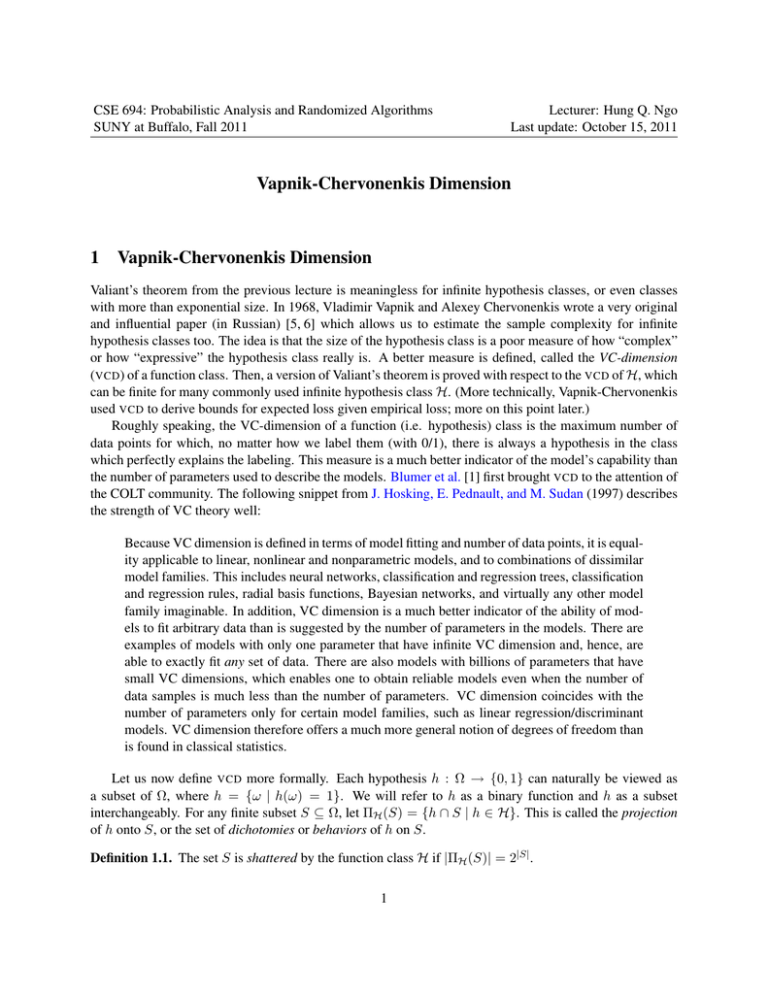CSE 694: Probabilistic Analysis and Randomized Algorithms Lecturer: Hung Q. Ngo
advertisement

CSE 694: Probabilistic Analysis and Randomized Algorithms
SUNY at Buffalo, Fall 2011
Lecturer: Hung Q. Ngo
Last update: October 15, 2011
Vapnik-Chervonenkis Dimension
1
Vapnik-Chervonenkis Dimension
Valiant’s theorem from the previous lecture is meaningless for infinite hypothesis classes, or even classes
with more than exponential size. In 1968, Vladimir Vapnik and Alexey Chervonenkis wrote a very original
and influential paper (in Russian) [5, 6] which allows us to estimate the sample complexity for infinite
hypothesis classes too. The idea is that the size of the hypothesis class is a poor measure of how “complex”
or how “expressive” the hypothesis class really is. A better measure is defined, called the VC-dimension
(VCD) of a function class. Then, a version of Valiant’s theorem is proved with respect to the VCD of H, which
can be finite for many commonly used infinite hypothesis class H. (More technically, Vapnik-Chervonenkis
used VCD to derive bounds for expected loss given empirical loss; more on this point later.)
Roughly speaking, the VC-dimension of a function (i.e. hypothesis) class is the maximum number of
data points for which, no matter how we label them (with 0/1), there is always a hypothesis in the class
which perfectly explains the labeling. This measure is a much better indicator of the model’s capability than
the number of parameters used to describe the models. Blumer et al. [1] first brought VCD to the attention of
the COLT community. The following snippet from J. Hosking, E. Pednault, and M. Sudan (1997) describes
the strength of VC theory well:
Because VC dimension is defined in terms of model fitting and number of data points, it is equality applicable to linear, nonlinear and nonparametric models, and to combinations of dissimilar
model families. This includes neural networks, classification and regression trees, classification
and regression rules, radial basis functions, Bayesian networks, and virtually any other model
family imaginable. In addition, VC dimension is a much better indicator of the ability of models to fit arbitrary data than is suggested by the number of parameters in the models. There are
examples of models with only one parameter that have infinite VC dimension and, hence, are
able to exactly fit any set of data. There are also models with billions of parameters that have
small VC dimensions, which enables one to obtain reliable models even when the number of
data samples is much less than the number of parameters. VC dimension coincides with the
number of parameters only for certain model families, such as linear regression/discriminant
models. VC dimension therefore offers a much more general notion of degrees of freedom than
is found in classical statistics.
Let us now define VCD more formally. Each hypothesis h : Ω → {0, 1} can naturally be viewed as
a subset of Ω, where h = {ω | h(ω) = 1}. We will refer to h as a binary function and h as a subset
interchangeably. For any finite subset S ⊆ Ω, let ΠH (S) = {h ∩ S | h ∈ H}. This is called the projection
of h onto S, or the set of dichotomies or behaviors of h on S.
Definition 1.1. The set S is shattered by the function class H if |ΠH (S)| = 2|S| .
1
Figure 1: Three non-colinear points are shattered by the set of half-planes
Figure 2: The class of half-planes cannot shatter 4 poitns in R2
In other words, the set S is shattered by H if, no matter how we assign 0/1-labels to points in S, there’s
always a hypothesis in H which “explains” the labeling perfectly. For example, let H be the set of halfplanes on R2 . Let S be any three points on R2 which are not colinear. Then, S is shattered by H because all
8 ways of assigning labels to S are explainable by the half-planes. See Figure 1 for an illustration.
Definition 1.2. The VC-dimension (VCD) of a function class (or hypothesis class) H is the maximum size
of a subset of Ω shattered by H.
In other words, if VCD(H) = d then H cannot shatter any d + 1 points and it can shatter some d points.
Figure 1 explains intuitively why the class of half-planes cannot shatter four points in R2 . We have thus
shown that the set of all half-planes on R2 has VCD = 3. Here are some examples which should make things
clearer:
Exercise 1. Show that
• If H is finite then VCD ≤ log2 |H|
• The set of all intervals [x, ∞), x ∈ R has VCD = 1.
2
• The set of all closed intervals on R has VCD = 2.
• The set of all axis-aligned rectangles on R2 has VCD = 4
• The set of all half-spaces on Rd has VCD = d+1
Exercise 2. Show that
• The set of all balls on Rd has VCD = d+1
• The set of all d-vertex convex polygons on R2 has VCD = 2d+1
• The set of all sets of intervals on R has VCD = ∞
We have claimed that VCD is a good measure of the “expressiveness” of a function class. Here is a result
which roughly states that if the concept class is too expressive then we cannot PAC-learn it. We will not
prove it formally because we shall prove a more general lower-bound in the next lecture.
Theorem 1.3. If the concept class C has VCD(C) = ∞, then there is no algorithm to PAC-learn C using C.
Proof. Fix = 1/8 and δ = 1/10. We can show that there exists a concept c ∈ C which no algorithm can
PAC-learn with error and confidence 9/10. The idea is to construct a particular probability distribution D
on Ω. Then, pick a random target concept c. Finally, show that the algorithm produces a hypothesis whose
expected error (over the random choices of c) is greater than .
2
Sauer-Shelah Lemma
We need the following lemma to prove the VC-dimension-based sample complexity theorem. The following
lemma was first proved by Vapnik-Chervonenkis [7], and rediscovered many times (Sauer [3], Shelah [4]),
among others. It is often called the Sauer lemma or Sauer-Shelah lemma in the literature. (Sauer said that
Paul Erdös posed the problem.)
Lemma 2.1 (Sauer-Shelah 1972). Suppose VCD (H) = d < ∞. Define the growth function
ΠH (m) = max {|ΠH (S)| : S ⊆ Ω, |S| = m} .
(Note that if VCD (H) = ∞ then ΠH (m) = 2m , ∀m.) Then,
ΠH (m) ≤ Φd (m) :=
d X
m
i
i=0
≤
em d
d
= O(md ).
Proof. Without loss of generality, we assume m > d, because if m ≤ d then Φd (m) = 2m and the
inequality is trivial.. Let S be an arbitrary set of m points from Ω. Let F = ΠH (S), then F is a family of
subsets of S. In fact, without loss of generality we set S = [m] (just rename the members of S). We will
show that |F| ≤ Φd (m).
We will use the “shifting technique” [2] to construct a family G of subsets of [m] satisfying the following
three conditions:
1. |G| = |F|
3
2. G is closed under containment, i.e. if A ∈ G, then every subset of A is in G.
3. Every A ⊂ [m] shattered by G is also shattered by F
So, instead of upperbounding |F| we can just upperbound G. Because G closed under containment, every
member of G is shattered by G, and thus every member of G is shattered by F. Thus, every member of G
has size at most d, implying |G| ≤ Φd (m) as desired.
We next describe the shifting operation which achieves properties 1, 2, 3 by an algorithm.
1: for i = 1 to m do
2:
for F ∈ F do
3:
if F − {i} ∈
/ F then
4:
Replace F by F − {i}
5:
end if
6:
end for
7: end for
8: Repeat steps 1–7 until no further changes is possible.
The algorithm terminates because some set gets smaller at each step. Properties 1 and 2 are easy to
verify.
We next verify that property 3 holds. Let A be shattered by F after executing lines 2–6 at any point
in the execution. We will show that A must have been shattered by F before the execution. Let i be the
element examined in that iteration. To avoid confusion, let F 0 be the set family after the iteration. We can
assume i ∈ A, otherwise the iteration does not affect the “shatteredness” of A.
Let R be an arbitrary subset of A. As A is shattered by F 0 , we know there is a set F 0 ∈ F 0 such that
F 0 ∩ A = R. If i ∈ R, then F 0 ∈ F. Suppose i ∈
/ R. There is T ∈ F 0 such that T ∩ A = R ∪ {i}. This
means T − {i} ∈ F , or else T would have been replaced in step 4. But, T − {i} ∩ A = R as desired.
Exercise 3 (Inductive proof of Sauer-Shelah lemma). We induct on m + d. The m = 0 and d = 0 cases are
trivial. Now consider m > 0, d > 0. Let S be an arbitrary set of m points from Ω. Rename members of S
so that S = [m]. Let F = ΠH ([m]). Define
F 0 = {F ⊆ [m − 1] | F ∈ F and F ∪ {m} ∈ F} .
Prove the followings:
(a) |F| = |F 0 | + |ΠF ([m − 1])|.
(b) ΠF ([m − 1]) = ΠH ([m − 1])
(c) VCD(F 0 ) ≤ d − 1.
(d) Finally, by applying the induction hypothesis, show that
|F| ≤ Φd−1 (m − 1) + Φd (m − 1) = Φd (m).
References
[1] A. B LUMER , A. E HRENFEUCHT, D. H AUSSLER , AND M. WARMUTH, Classifying learnable geometric concepts with the
vapnik-chervonenkis dimension, in Proceedings of the eighteenth annual ACM symposium on Theory of computing, STOC
’86, New York, NY, USA, 1986, ACM, pp. 273–282.
4
[2] P. F RANKL, Shadows and shifting, Graphs Combin., 7 (1991), pp. 23–29.
[3] N. S AUER, On the density of families of sets, J. Combinatorial Theory Ser. A, 13 (1972), pp. 145–147.
[4] S. S HELAH, A combinatorial problem; stability and order for models and theories in infinitary languages, Pacific J. Math., 41
(1972), pp. 247–261.
[5] V. N. VAPNIK AND A. Y. C HERVONENKIS, On the uniform convergence of relative frequencies of events to their probabilities,
Doklady Akademii Nauk USSR, 181 (1968).
[6]
, On the uniform convergence of relative frequencies of events to their probabilities, Theory of Probability and its
Applications, 16 (1971), pp. 264–280.
[7]
, Theory of uniform convergence of frequencies of events to their probabilities and problems of search for an optimal
solution from empirical data, Avtomat. i Telemeh., (1971), pp. 42–53.
5






